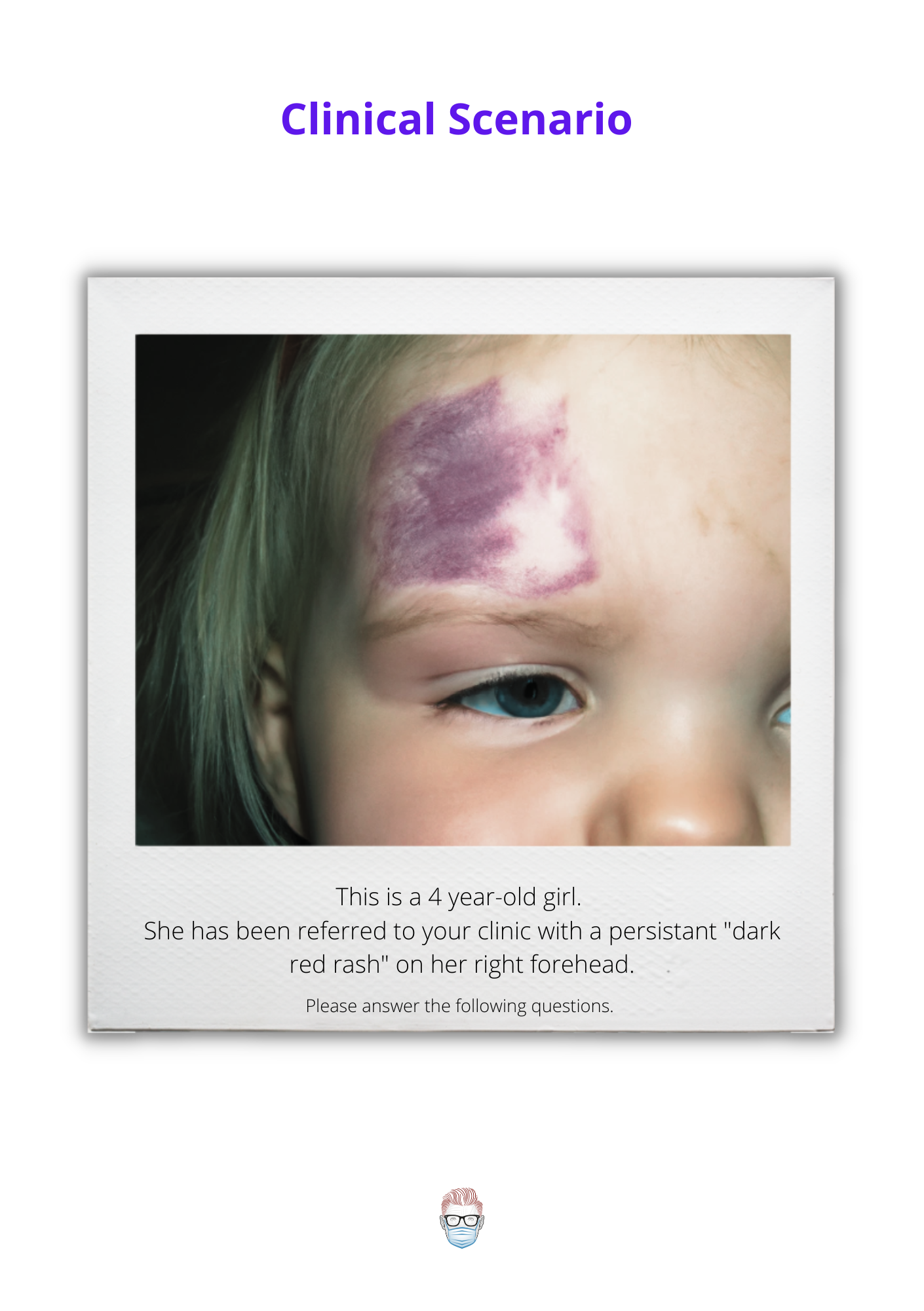
Objectives
1. Clinical diagnosis of a vascular malformation
2. Create and justify a differential diagnosis
3. Describe the natural history and aetiology of this condition
4. Identify and treat complications and associated conditions
5. Order relevant investigations
6. Treat this condition in the short and long term
Section 1
Clinical Assessment and Diagnosis
Comment on this patient's face.
This patient has a pink-red, well-defined, flat macular lesion on her right forehead. These features are clinically consistent with a capillary malformation. Most likely, a cutaneous capillary malformation.
It appears to be in the territory of the ophthalmic division of the trigeminal nerve. My concern would be for Sturge Weber Syndrome.
I complete my examination by looking for mucosal capillary malformations and midline and cephalic cutaneous malformations.
What questions would you like to ask the parents?
Firstly, in terms of the lesion:
- Present at birth (congenital hemangioma or vascular malformation)
- Growing in proportion with the body (tumour) or no change to size (malformation)
- Preceded by a herald patch (infantile hemangioma)
- Has it started to shrink? (involution infantile hemangioma or a rapid-involvuting congential hemangioma)
Secondly, in terms of the patient:
- Any antenatal/pregnancy-related issues
- Neonatal or infantile issues such as seizure or visual disturbances.
Finally, in terms of the parents:
- Obstetric History
- Family History
- Pyschosocial supports
Section 2
Treatment and Investigations
Explain the diagnosis of a capillary malformation to the parents.
A capillary malformation, also known as a "port wine stain," is a type of birthmark caused by dilated blood vessels in the skin. It appears as a flat, pink, red, or purple mark on the skin, usually on the face, neck, or arms. It is a benign condition and does not require treatment.
However, it is important to note that in rare cases, capillary malformations can be associated with other medical conditions such as Sturge-Weber syndrome, which can affect the nervous system and cause seizures. Therefore, if a capillary malformation is present on the face, it is important to monitor the child's development and consult a neurologist if there are any concerns.
As your child ages, the skin around the malformation may become thicker, and the colour may become darker. In some cases, the malformation may also become more noticeable due to changes in skin tone or the development of wrinkles.
If the parents or patient wishes, it can be treated with laser therapy, but it's important to note that the treatment may not completely remove the malformation and multiple sessions are often required.
Would you consider any specific investigations for this patient?
Yes, I would order an MRI brain as I am concerned about Sturge-Weber Syndrome. This may identify ipsilateral leptomeningeal anomalies. If the capillary malformation is midline spinal, I would also MRI this area to identify any possible encephalocele or spinal dysraphism.
I would also arrange a neurology opinion and ask for an ophthalmology consult, as this condition can be associated with glaucoma.
The mother informs you that she had a red patch between her eyes. What is she most likely referring to?
The mother most likely had a naevus simplex, also referred to as a angel kiss. They classically occur in the glabellar or nape of neck. Over time these flat pale pink lesions fade and do not require treatment.


